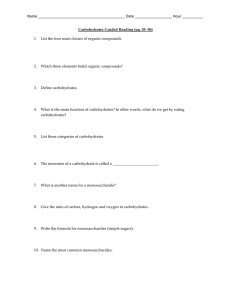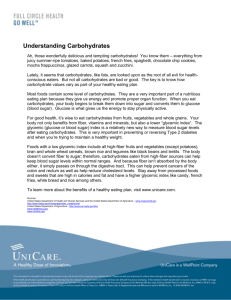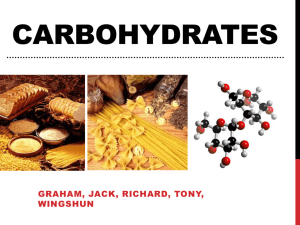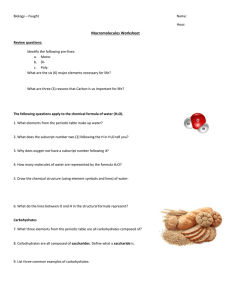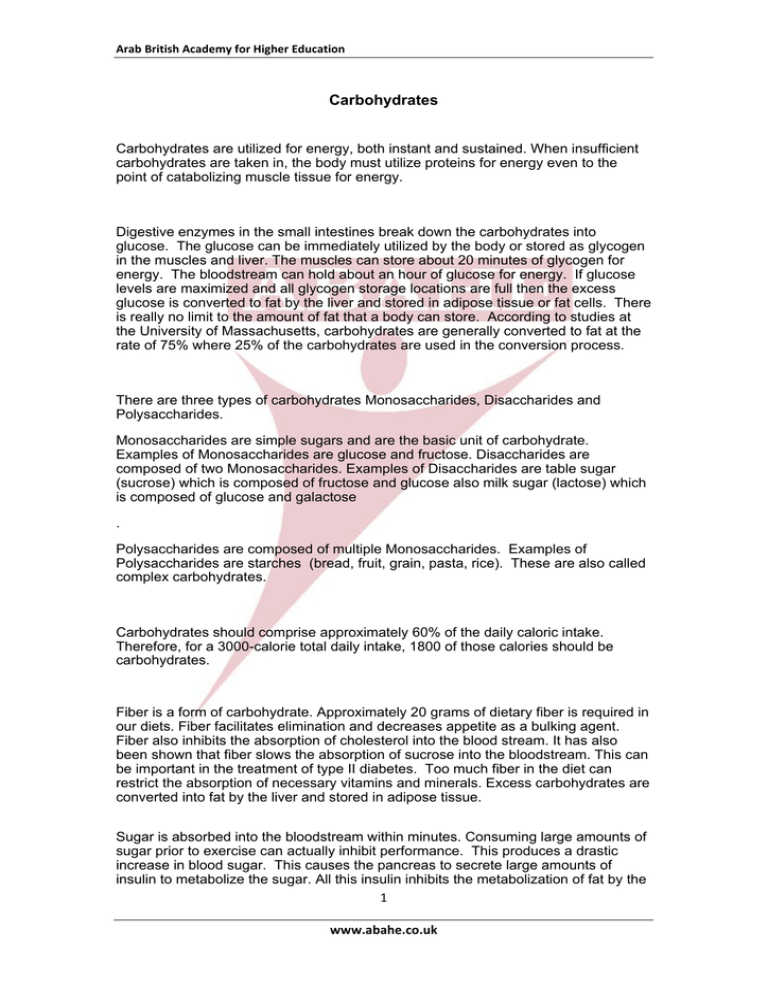
Arab British Academy for Higher Education Carbohydrates
Carbohydrates are utilized for energy, both instant and sustained. When insufficient
carbohydrates are taken in, the body must utilize proteins for energy even to the
point of catabolizing muscle tissue for energy.
Digestive enzymes in the small intestines break down the carbohydrates into
glucose. The glucose can be immediately utilized by the body or stored as glycogen
in the muscles and liver. The muscles can store about 20 minutes of glycogen for
energy. The bloodstream can hold about an hour of glucose for energy. If glucose
levels are maximized and all glycogen storage locations are full then the excess
glucose is converted to fat by the liver and stored in adipose tissue or fat cells. There
is really no limit to the amount of fat that a body can store. According to studies at
the University of Massachusetts, carbohydrates are generally converted to fat at the
rate of 75% where 25% of the carbohydrates are used in the conversion process.
There are three types of carbohydrates Monosaccharides, Disaccharides and
Polysaccharides.
Monosaccharides are simple sugars and are the basic unit of carbohydrate.
Examples of Monosaccharides are glucose and fructose. Disaccharides are
composed of two Monosaccharides. Examples of Disaccharides are table sugar
(sucrose) which is composed of fructose and glucose also milk sugar (lactose) which
is composed of glucose and galactose
.
Polysaccharides are composed of multiple Monosaccharides. Examples of
Polysaccharides are starches (bread, fruit, grain, pasta, rice). These are also called
complex carbohydrates.
Carbohydrates should comprise approximately 60% of the daily caloric intake.
Therefore, for a 3000-calorie total daily intake, 1800 of those calories should be
carbohydrates.
Fiber is a form of carbohydrate. Approximately 20 grams of dietary fiber is required in
our diets. Fiber facilitates elimination and decreases appetite as a bulking agent.
Fiber also inhibits the absorption of cholesterol into the blood stream. It has also
been shown that fiber slows the absorption of sucrose into the bloodstream. This can
be important in the treatment of type II diabetes. Too much fiber in the diet can
restrict the absorption of necessary vitamins and minerals. Excess carbohydrates are
converted into fat by the liver and stored in adipose tissue.
Sugar is absorbed into the bloodstream within minutes. Consuming large amounts of
sugar prior to exercise can actually inhibit performance. This produces a drastic
increase in blood sugar. This causes the pancreas to secrete large amounts of
insulin to metabolize the sugar. All this insulin inhibits the metabolization of fat by the
1 www.abahe.co.uk Arab British Academy for Higher Education muscles. Therefore, the muscles rely more on glycogen, which is in limited supply.
The insulin reduces blood sugar level, which is already being reduced by the muscle
utilization of glycogen stores for energy production. The blood sugar level reduces to
a level, which may not only cause fatigue but dizziness as well. Therefore
consumption of excess sugar prior to exercise reduces performance and endurance.
Carbohydrate Loading
Carbohydrate loading is when an athlete depletes and then force-feeds
carbohydrates over a period of several days. Carbohydrates are first depleted, for
example on a long fast run, then large amounts of carbohydrates eaten. The theory is
that the body will overcompensate and store extra glycogen.
Carbohydrate Stacking
This technique requires the consumption of several different kinds of carbohydrates
each assimilated by the body at different rates based on their glycemic value. Eating
a high glycemic food provides immediate energy while a low glycemic food provides
energy at a slower controlled rate. This technique provides greater endurance for
athletes.
2 www.abahe.co.uk Arab British Academy for Higher Education All Rights Reserved © Arab British Academy for Higher Education 3 www.abahe.co.uk

